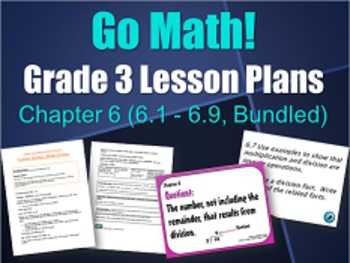UPDATED Go Math Grade 3 Lesson Plans, Chapter 6 (6.1 - 6.9, Bundled)
MrTechnology
931 Followers
Grade Levels
3rd
Subjects
Resource Type
Standards
CCSS3.OA.A.2
CCSS3.OA.A.3
CCSS3.OA.A.4
CCSS3.OA.B.5
CCSS3.OA.B.6
Formats Included
- Zip
Pages
34 pages
MrTechnology
931 Followers
Description
*** UPDATED FOR THE 2015-16 SCHOOL YEAR ***
Grade 3 Go-Math Lesson Plans for Chapter 6 (6.1 - 6.9) is a 25-page bundle in Microsoft Word (editable for your specific class needs).
- Bundle/Chapter includes lesson plans for:
- Problem Solving – Model Division
- Size of Equal Groups
- Number of Equal Groups
- Model with Bar Models
- Algebra – Relate Subtraction & Division
- Investigate – Model with Arrays
- Algebra – Write Related Facts
- Algebra – Division Rules for 1 and 0
Bundle also includes newly designed Math Journal Prompts and Chapter 6 Math Vocabulary Posters!
(c) MrTechnology, 2015
Total Pages
34 pages
Answer Key
N/A
Teaching Duration
2 Weeks
Report this resource to TPT
Reported resources will be reviewed by our team. Report this resource to let us know if this resource violates TPT’s content guidelines.
Standards
to see state-specific standards (only available in the US).
CCSS3.OA.A.2
Interpret whole-number quotients of whole numbers, e.g., interpret 56 ÷ 8 as the number of objects in each share when 56 objects are partitioned equally into 8 shares, or as a number of shares when 56 objects are partitioned into equal shares of 8 objects each. For example, describe a context in which a number of shares or a number of groups can be expressed as 56 ÷ 8.
CCSS3.OA.A.3
Use multiplication and division within 100 to solve word problems in situations involving equal groups, arrays, and measurement quantities, e.g., by using drawings and equations with a symbol for the unknown number to represent the problem.
CCSS3.OA.A.4
Determine the unknown whole number in a multiplication or division equation relating three whole numbers. For example, determine the unknown number that makes the equation true in each of the equations 8 × ? = 48, 5 = __ ÷ 3, 6 × 6 = ?.
CCSS3.OA.B.5
Apply properties of operations as strategies to multiply and divide. Examples: If 6 × 4 = 24 is known, then 4 × 6 = 24 is also known. (Commutative property of multiplication.) 3 × 5 × 2 can be found by 3 × 5 = 15, then 15 × 2 = 30, or by 5 × 2 = 10, then 3 × 10 = 30. (Associative property of multiplication.) Knowing that 8 × 5 = 40 and 8 × 2 = 16, one can find 8 × 7 as 8 × (5 + 2) = (8 × 5) + (8 × 2) = 40 + 16 = 56. (Distributive property.)
CCSS3.OA.B.6
Understand division as an unknown-factor problem. For example, find 32 ÷ 8 by finding the number that makes 32 when multiplied by 8.





